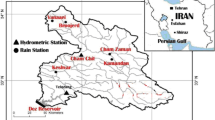Abstract
Environmental flow is necessary to maintain a healthy ecosystem and sustain aquatic lives. Its assessment is thus aimed at analysing the minimum flow of water required for sustainability of the ecosystem. In the present study, an effort has been made to describe the environmental flow condition of a watershed with the help of a Standardized Precipitation Index (SPI), an index often used in drought prediction using precipitation. Among the various drought indices, SPI is very popular and widely used for drought monitoring. SPI is advantageous over other indices as, for example, it requires easily available precipitation data and enables drought monitoring at different timescales, such as monthly, seasonal, annual. On the other hand, the Tennant method requires flow data, which is too scarce in ungauged catchments. This study attempts to correlate the concepts of Tennant and SPI to explore the ability of SPI to predict environmental flow conditions using rainfall. The rainfall and runoff data for the period of 1990–2000 of five watersheds of Godavari Basin, namely Hivra, Kumhari, Nandgaon, Ramakona, and Satrapur, have been analysed. SPI at 9-month timescale for the month of June and the percentage of average annual flow for the same period were determined for respective watersheds separately. When plotted, both correlated positively with coefficient of determination of 0.74 for three (out of 5) catchments, suggesting a very good fit. The relationship indicates significant dependence of environmental flow on SPI, and it can be used for deriving the EF condition for a watershed/gauging site based on SPI, easily derivable from the available rainfall data.



Similar content being viewed by others
References
Amrit K, Mishra SK, Pandey RP (2017) Prediction of environmental flow condition using the Standardized Precipitation Index in Mahanadi Basin, India. In: World environmental and water resources congress, pp 294–301
Brisbane Declaration (2007) The Brisbane declaration: environmental flows are essential for freshwater ecosystem health and human well-being, September 3–6, Brisbane, Australia
Byun HR, Wilhite DA (1999) Objective quantification of drought severity and duration. J Clim 12(9):2747–2756
China-Z (2001) Index and the statistical Z-score. Int J Climatol 21(6):745–758
Dayal KS, Deo RC, Apan AA (2017) Investigating drought duration-severity-intensity characteristics using the Standardized Precipitation-Evapotranspiration Index: case studies in drought-prone Southeast Queensland. J Hydrol Eng 23(1):05017029
Edossa DC, Babel MS, Das Gupta A (2010) Drought analysis in the Awash river basin, Ethiopia. Water Resour Manage 24(7):1441–1460
Edwards DC, McKee TB (1997) Characteristics of 20th century drought in the united states at multiple scales. Atmospheric science paper no. 634, pp 1–30
Hatfield T, Lewis A, Ohlson D, Bradford M (2003) Development of instream flow thresholds as guidelines for reviewing proposed water uses. Consultants report for British Columbia Ministry of Sustainable Resource Management and British Columbia Ministry of Water, Land and Air Protection. Victoria, BC, 88 pp
Hayes MJ, Svoboda MD, Wilhite DA, Vanyarkho OV (1999) Monitoring the 1996 drought using the standardized precipitation index. Bull Am Meteor Soc 80(3):429–438
Jacobsen D, Milner A, Brown L, Dangles O (2012) Biodiversity under threat inglacier-fed river systems. Nat Clim Change 2:361–364
Kirby JM, Connor J, Ahmad MD, Gao L, Mainuddin M (2014) Climate change and environmental water reallocation in the Murray–Darling Basin: impacts on flows, diversions and economic returns to irrigation. J Hydrol 518:120–129
Mann JL (2006) Instream flow methodologies: an evaluation of the Tennant method for higher gradients streams in national forest system land in Western U.S. M.Tech. Thesis Colorado State University, 158
Mazvimavi D, Madamombe E, Makuria H (2007) Assessment of environmental flow requirements for river basin planning in Zimbabwe. Phys Chem Earth 32:995–1006
McKee TB, Doesken NJ, Kleist J (1993) The relationship of drought frequency and duration to time scales. Paper presented at 8th conference on applied climatology. American Meteorological Society, Anaheim, CA
Nam WH, Hayes MJ, Svoboda MD, Tadesse T, Wilhite DA (2015) Drought hazard assessment in the context of climate change for South Korea. Agric Water Manag 160:106–117
Poff NL (2009) Managing for variability to sustain freshwater ecosystems. J Water Resour Plan Manag 21:435–456
Spinoni J, Naumann G, Vogt JV (2017) Pan-European seasonal trends and recent changes of drought frequency and severity. Glob Planet Change 148:113–130
Tennant DL (1975) Instream flow regimens for fish, wildlife, recreation and related environmental resources. U.S. Fish and Wildlife Service, Federal Building, Billings, MT, 30 pp
Tennant DL (1976a) Instream flow regimens for fish, wildlife, recreation and related environmental resources. In: Orsborn JF, Allman CH (eds) Proceedings of the symposium and specialty conference on instream flow needs. American Fisheries Society, Bethesda, pp 359–373
Tennant DL (1976b) Instream flow regimens for fish, wildlife, recreation, and related environmental resources. Fisheries 1(4):6–10
Tharme RE (2003) A global perspective on environmental flow assessment: emerging trends in the development and application of environmental flow methodologies for rivers. River Res Appl 19:397–441
Van Vliet MTH, Franssen WHP, Yearsley JR, Ludwig F, Haddeland I, Letten-maier DP, Kabat P (2013) Global river discharge and water temperature under climate change. Glob Environ Change 23:450–464
Vörösmarty CJ, McIntyre PB, Gessner MO, Dudgeon D, Prusevich A, Green P, Glidden S, Bunn SE, Sullivan CA, Liermann CR, Davies PM (2010) Global threats to human water security and river biodiversity. Nature 467:555–561
Wang and Lu (2009) Quantitative estimation models and their application of ecological water use at a basin scale. Procedia Environ Sci 13:1559–1568
Wu H, Hayes MJ, Weiss A, Hu Q (2001) An evaluation of the Standardized Precipitation Index, the China-Z Index and the statistical Z-Score. Int J Climatol 21(6):745–758
Zhang Q, Xiao M, Singh VP, Li J (2012) Regionalization and spatial changing properties of droughts across the Pearl River basin, China. J Hydrol 472:355–366
Author information
Authors and Affiliations
Corresponding author
Rights and permissions
About this article
Cite this article
Mishra, S.K., Amrit, K. & Pandey, R.P. Correlation between Tennant method and Standardized Precipitation Index for predicting environmental flow condition using rainfall in Godavari Basin. Paddy Water Environ 17, 515–521 (2019). https://doi.org/10.1007/s10333-019-00747-w
Received:
Revised:
Accepted:
Published:
Issue Date:
DOI: https://doi.org/10.1007/s10333-019-00747-w




